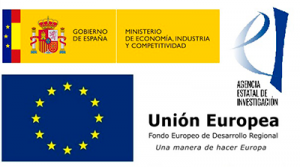 |
PIs: Francisco Yubero, Angel Barranco (Jan-2017/Dec-2019) |
Read more …
NANOFlow is a multidisciplinary Project that aims the development of novel optofluidics sensing devices integrating advanced multifunctional nanostructured materials. The project is solidly grounded in the research group experience in the synthesis of nanoestructured functional thin films, advance surface treatments and development of planar photonic structures The main objective of the project is to combine and integrate the available synthetic and processing methodologies in the fabrication of optofluidic components capable of modifying their physical behavior when they are exposed to liquids. The integration of these optofluidic components together with accessory technologies based on new principles of photonic detection, large surface area microplasmas discharge as light sources or flexible substrates for the fabrication of sensing tags define an ambitious landscape of applications that will be explored in the project. Besides, the modeling of thin film growth in combination with advanced deposition diagnosis methodologies will be combined to adjust the thin film deposition processes to the desired functionalities.Therefore, NANOFlow aims to cover all the scientific-technological chain from the materials development to the final applications including advanced characterization, flexible synthetic routes, alternative low-cost and high throughput process (e.g. atmospheric plasma synthesis), device integration and testing of devices in real conditions.
The NANOFlow research activities will culminate in the development of three innovative devices, namely smart labels for sensing, traceability and anticounterfeiting applications (e.g. smart labels incorporated in food-packaging), a versatile optofluidic multisensing device and an optofluidic photocatalytic cleaning system that will integrate a large area microplasma source, liquid actuated UV/Visible optical switches and a photocatalytic nanostructured surface. All of these devices will operate under the basis of an optofluidic actuation and/or response and are designed to present clear potentialities for direct application in liquid sensing, manipulation and monitoring.
The NANOFlow research activities in the different work-packages and, particularly, the final devices are intended to have a direct impact in the Theme 2 (Seguridad and Calidad Alimentaria) of the “RETOS” defined in the call covering this project proposal.. Besides, some of the activities proposed, in particular the third device are also connected with the Theme 3 (Energía segura eficiente y limpia) of the call. It is very interesting to stress that these activities are of particular relevance in the geographical context of Andalucia where Agriculture, Food production and Energy are three of the most relevant strategic sectors.
|
Financial source: Agencia Estatal de Investigación (AEI) y Fondo Europeo de Desarrollo Regional (FEDER) Code: MAT2016-79866-R Acronym: NANOFLOW
|
Research team: Agustin R. Gonzalez-Elipe (ICMS-CSIC), José Cotrino (ICMS-US), Juan Pedro Espinós (ICMS-CSIC), Fabián Frutos (US), Ana I. Borrás (ICMS-CSIC), Alberto Palmero (ICMS-CSIC), Victor Rico (ICMS-CSIC), Angel Barranco (ICMS-CSIC), F. Yubero (ICMS-CSIC), Ricardo Molina (IQAC-CSIC), Fernando Lahoz (ULL), Xerman de la Fuente (ICMA-CSIC), Jesús Cuevas (US), Mª Fe Laguna (UPM), Antonio Rodero (UCO), Mª Carmen García (UCO) Work team doctors: Juan R. Sánchez-Valencia, Francisco J. Aparicio, Jorge Gil-Rostra, Victor López, Rafael Alvarez, M.C. López-Santos, Francisco J. García, Ana M. Gómez, María Alcaire |

